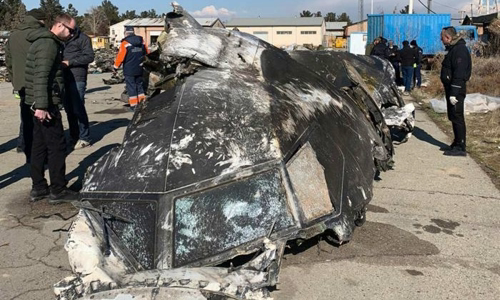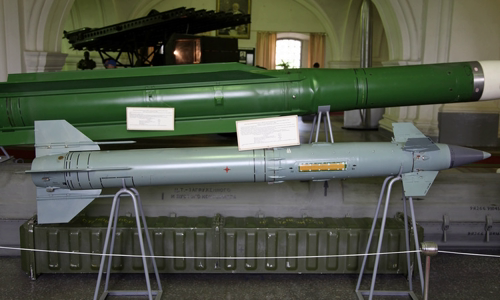Tor-M1 missiles are optimized for small targets such as cruise missiles, difficult to completely destroy Boeing 737 passenger aircraft.
Footage from a security camera on the outskirts of Tehran, released on January 14, showed that the Boeing 737-800 of Ukraine International Airlines (UIA) was hit by two Iranian air defense missiles early in the morning.

The cockpit fragment of an Ukrainian plane was shot down by Iran Photo: AFP
After the first rocket exploded, the aircraft continued its journey. 23 seconds later, the second bullet to be launched continues to hit the aircraft. However, this aircraft did not explode in the air, but continued to fly right. More than a minute later, the aircraft began to ignite in the air, before crashing into the outskirts of Tehran and breaking into thousands due to the force of the impact.
Experts believe that the characteristics of the Iranian air defense missile, the structure of the Boeing 737-800 aircraft and the height of the aircraft when hit by the missiles are factors that prevent the aircraft from shattering in the air like a tragedy. MH17 in Ukraine 2014.
"The plane can still fly after being hit by a rocket. It all depends on the size of the aircraft, the tip of the rocket and the location of the bullet," aviation doctor Dr. Robert Ball wrote in his book "Fundamentals." in the Design and Analysis of the viability of military aircraft ".
US intelligence and experts say the weapon used by Iranian air defense in the accidental shooting of a Ukrainian aircraft was a Russian-made Tor-M1 missile. This is a system developed to deal with small targets such as cruise missiles, guided bombs and unmanned aircraft.
Each 9M331 shell of the Tor-M1 complex has a 15 kg heavy warhead, guided by radio waves and installed close-in fuses, allowing the target to be killed without direct collision.
"This design makes the Tor-M1 easy to kill small, high-speed targets like cruise missiles close to the ground but having difficulty with large objects such as bombers, or in this case, aircraft. passenger, "commented Michael Elleman, a missile defense specialist at the International Institute for Strategic Studies (IISS).
America's AGM-86 ALCM cruise missile, the weapon driving the birth of Tor, is about 6.3 meters long and has a wingspan of 3.7 meters. Meanwhile, the Boeing 737-800 has a length of 40 m and a wingspan of 34 m.
When detonated, the warhead of 9M331 can shoot hundreds to thousands of metal pieces in all directions. If the target is a cruise missile, this "fragment cloud" will destroy the structure and almost immediately disable the shell. But when exploded near a large passenger aircraft, the splinters will penetrate the fuselage, causing internal casualties and possibly damaging the electronic, hydraulic, and control systems of the aircraft. .
"Pictures of Ukrainian aircraft wrecks show many holes in the fuselage and no sign of exploding from inside, showing that Iranian missiles only detonated near the aircraft and did not hit the target," Elleman said. more.
Ukraine's Defense Security Secretary Oleksiy Danilov said the rocket exploded just below the cockpit of the Boeing 737-800, causing the pilot to be severely injured or killed instantly after being hit by a splint. "That is why they did not contact or send emergency signals," he added.
The Tor 15-piece fragment detonator is capable of destroying cruise missiles from a few meters away, but it is difficult to immediately destroy a passenger plane unless there is a direct collision.
For comparison, S-75 and S-200 air-to-air anti-aircraft missiles often carry a 150-200 kg piece warhead, allowing them to completely destroy large aircraft with a single hit. hit the target.
The Buk rocket, the weapon system used to shoot down MH17 aircraft in Ukraine in 2014, has a 70 kg explosive warhead. The fragments of the Buk rocket ripped apart the fuselage, causing it to shatter at an altitude of over 10,000 meters, with parts of the aircraft and the bodies of the victims falling scattered over a very large area.
Meanwhile, UIA's plane is most likely damaged only critical control components after being hit by two rockets. The shot at an altitude of 2,400 m prevented the aircraft from being depressed like MH17, so the body of the aircraft remained intact. The explosive warhead on the cockpit side is unlikely to affect the engine of the aircraft.

9M330 missile of the Tor system (gray) compared to the shell of Buk medium-range air defense complex Photo: Wikimedia Commons
For those reasons, the Boeing 737-800 could continue its journey for nearly two minutes after hitting the second rocket. The right turn of the aircraft could be the pilot's last attempt to bring the plane back to the airport before being killed by the splinter.
However, onboard systems cannot withstand the overwhelming destruction of countless high-speed metal shards. The shorted electrical system could have sparked sparks in the leaking fuel, causing the aircraft to start burning violently. The plane was quickly enveloped by flames and dived down at great speed.
Historically there have been many cases of passenger planes being hit by rockets, but the pilot kept the plane under control for many minutes.
On April 20, 1978, Korean Air Lines Boeing 707 flew into Soviet airspace and was approached by two Su-15 fighters. The two sides could not connect, so Soviet air defense was ordered to shoot down Korean aircraft.
Su-15 fighters launched two R-60 short-range air-to-air missiles, one of which hit and blew part of the left wing of the Boeing 707. The rocket splash also penetrated the body of the Boeing 707, causing pressure drop. and jammed one of the 4 jet engines. Despite this, the crew still controlled the aircraft and landed an emergency landing on the ice lake near the Soviet-Finnish border.
There are 109 passengers and crew members on board. One person died on board due to rocket fragments and another died from a severe injury while waiting for rescue.
On September 1, 1983, a Soviet Su-15 fighter launched two K-8 surface-to-air missiles against Korean Air Lines' Boeing 747 allegedly violating the country's airspace. These two 40 kg heavy rocket detonators detonated about 50 meters from the tail of the passenger plane.
Missile rocket fragments caused the Boeing 747 to fail 3 of the 4 hydraulic systems and tear its tail, the body suffered a hole that caused a sudden drop in pressure. However, the pilot remained in control of the aircraft for 5 minutes and reported an air traffic incident in Japan. The plane then lost control and plunged into the sea, killing 269 people.



 CarolJohnsonTurner
CarolJohnsonTurner







